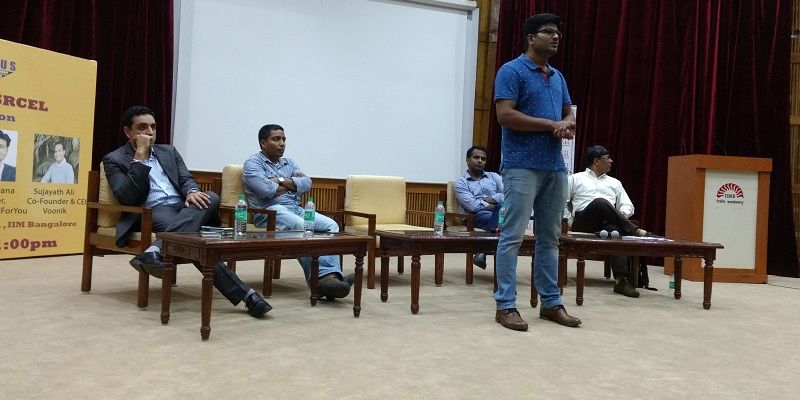How do online platforms build businesses? Key takeaways from Voonik, ZopNow, and HouseMaidForYou
While there might be a lot of talk about e-commerce businesses not focusing on business, on Saturday at IIM Bangalore event Eximus these very players spoke of the different elements that go into making an online business work.
In a panel made up of Mukesh Singh, Founder, ZopNow; Sujayath Ali, Co-founder and CEO, Voonik; Prateek Rana, Co-founder, HouseMaidForYou; and Mohit Gulati, Founder, Altius Ventures, the three founders and one VC spoke about solving what is commonly known as the chicken and egg problem. Do you focus on customer acquisition and hence not make money, or focus on making money and then think about customer acquisition?

Focus on building a strong product
The four panellists agreed that the most important thing that can either make or break a brand and even decide the stickiness of the customer is the product.
While you can spend marketing dollars and manpower, to acquire a customer, it is important to create a seamless experience. This is especially true when starting up, as this is the only thing customers will trust and believe you on.
Speaking of the early days, Sujayath stresses upon how important it is to build the product and focus on what is more important — the suppliers or the customers. He says,
The only company I had worked with and knew was Amazon. There I focused on the product and I didn’t do anything different at Voonik.
While working with the highly unorganised workforce, Prateek says it is very important to ensure every aspect of the system works. He says,
Domestic labour isn’t even considered under labour in our country. For us, the product had to work in such a way that it helps get and work with domestic help in a professional manner.
Unlike a Flipkart, Jabong, or Myntra, Voonik found that their customer base was women in tier II and tier III cities. For them, the same fashion rules as the ones in metros didn’t work, which was why the team decided to focus on communication that suited these women and the fashion they need.
Lessons on customer acquisition — work along what works best for you
For some platforms, customer acquisition comes first and for some others it’s supply. But then if you acquire customers, you need the supply. However, for Sujayath, customer acquisition was very tricky. He says,
I had one core belief: a seller will come to you if there is a demand. No matter how inconvenient it is, they will come to you. But that just isn’t the case with customers.
So Voonik decided to focus on consumer acquisition, and for supply they tied up with bigger marketplaces. Though Voonik is an affiliate platform, it doesn’t work like the other platforms. If a customer clicks on something at Voonik, he or she will go through the entire transaction on their platform itself. “We just tied up with other affiliate networks,” says Sujayath.
Every seller relationship is unique. You need to find your way into onboarding people. Sujayath added that in 2014, the game was around GMV (Gross Merchandise Value), and they worked along those games.
However, for a business like e-grocery, the challenges are very different. Mukesh adds that you need to look at it from a locality-by-locality approach, especially in the early days. They found that newspaper pamphlets worked the best for the market.
Being in a business that already had a strong latent demand, customer acquisition wasn’t a difficult task for Prateek.
They already had media covering them which helped them gain the eyeballs, and when they were ready to launch, they already had a database of 150 customers waiting in line.
Lessons on unit economics — it is about being realistic about what is possible given the realities of the business
Speaking of the tricky balance between unit economics and customer acquisition, Mukesh says,
You need to break the first customers in and give in the first 10 orders, which is possibly the toughest. But the challenges increase with scale. Especially when it comes to delivering after 1,000 orders, there are some harsh realities of unit economics that you need to keep in mind.
He adds that for a 95 percent clear online delivery work, it adds an extra 50 percent of money. “You therefore need to put in realistic metrics based on how the unit economics works,” says Mukesh.
On all three platforms, one of the key parameters that worked as a challenge for all was bringing in scale and focusing on actual promise. Across the panel, one thing was clear — the startup scene today is heading back to the basics. It has become important that the LTV (life time value) exceeds the CPA (cost per acquisition). Mukesh adds that now, with sanity prevailing, the ecosystem is likely to become stronger and far more superior.











